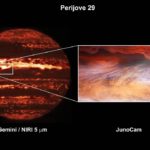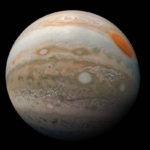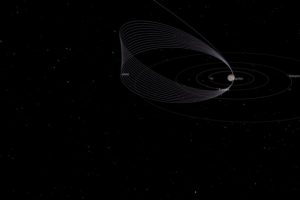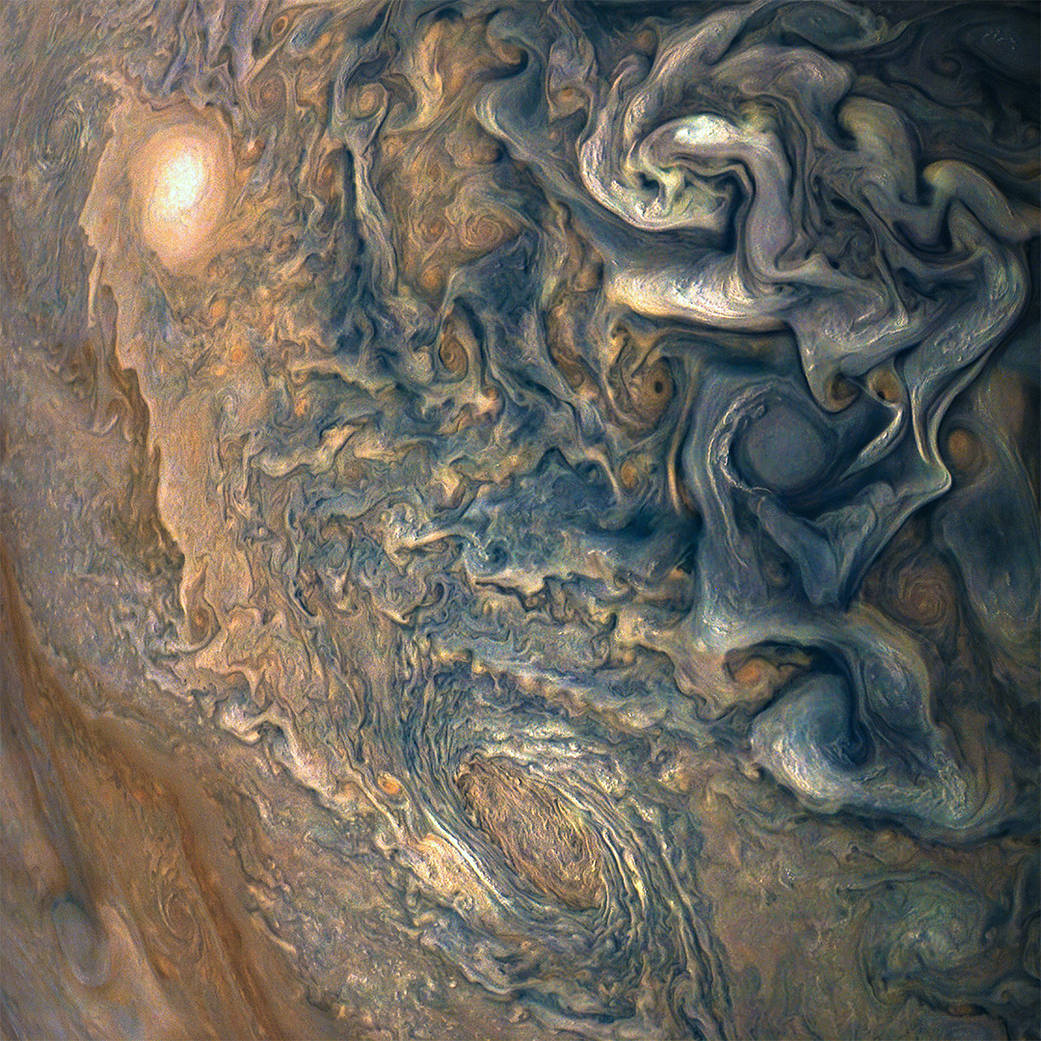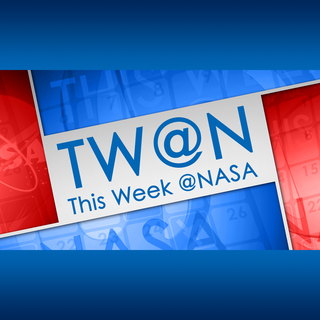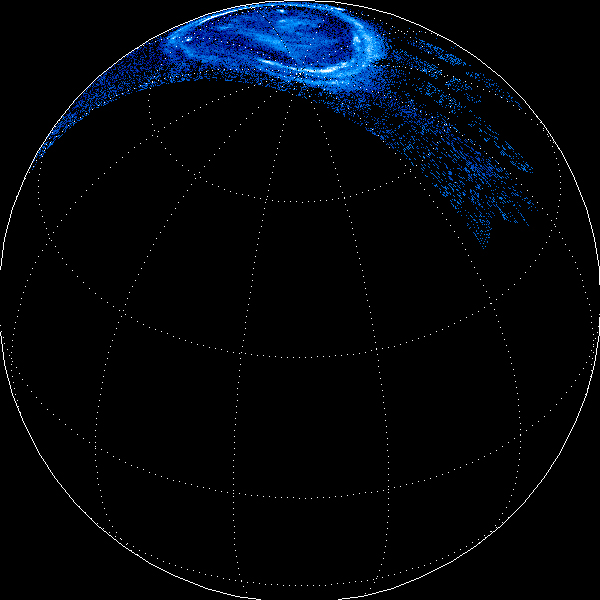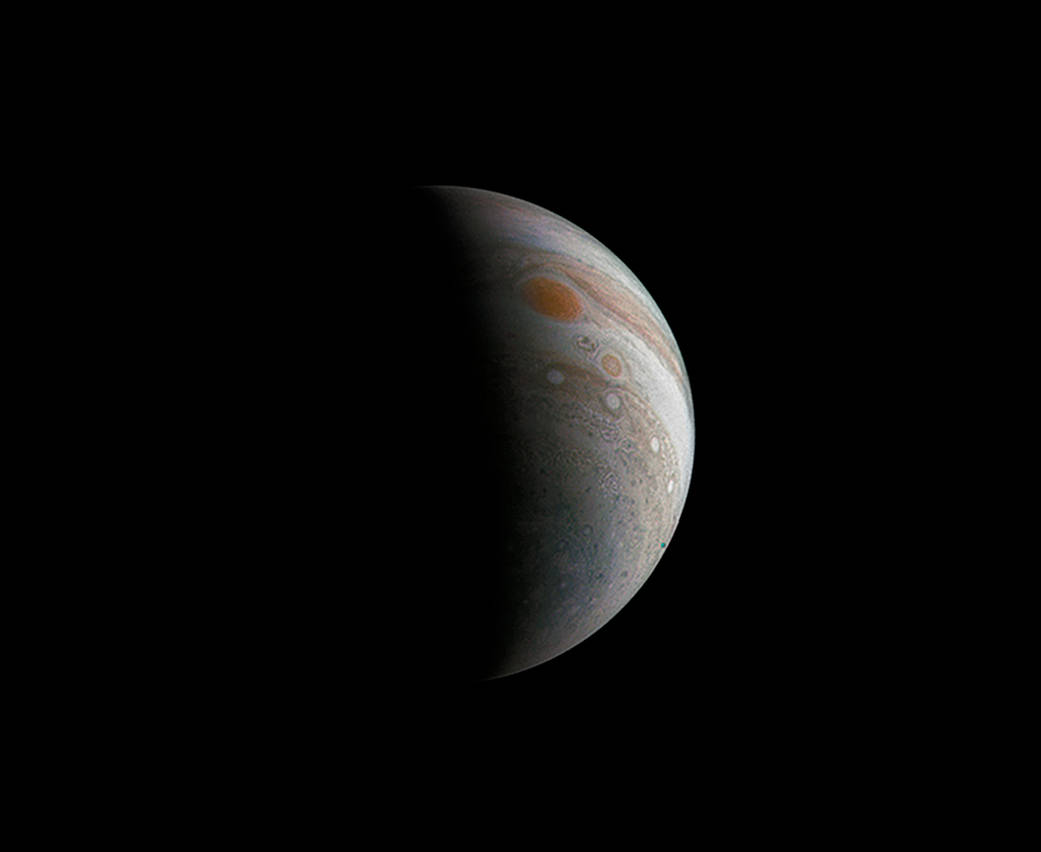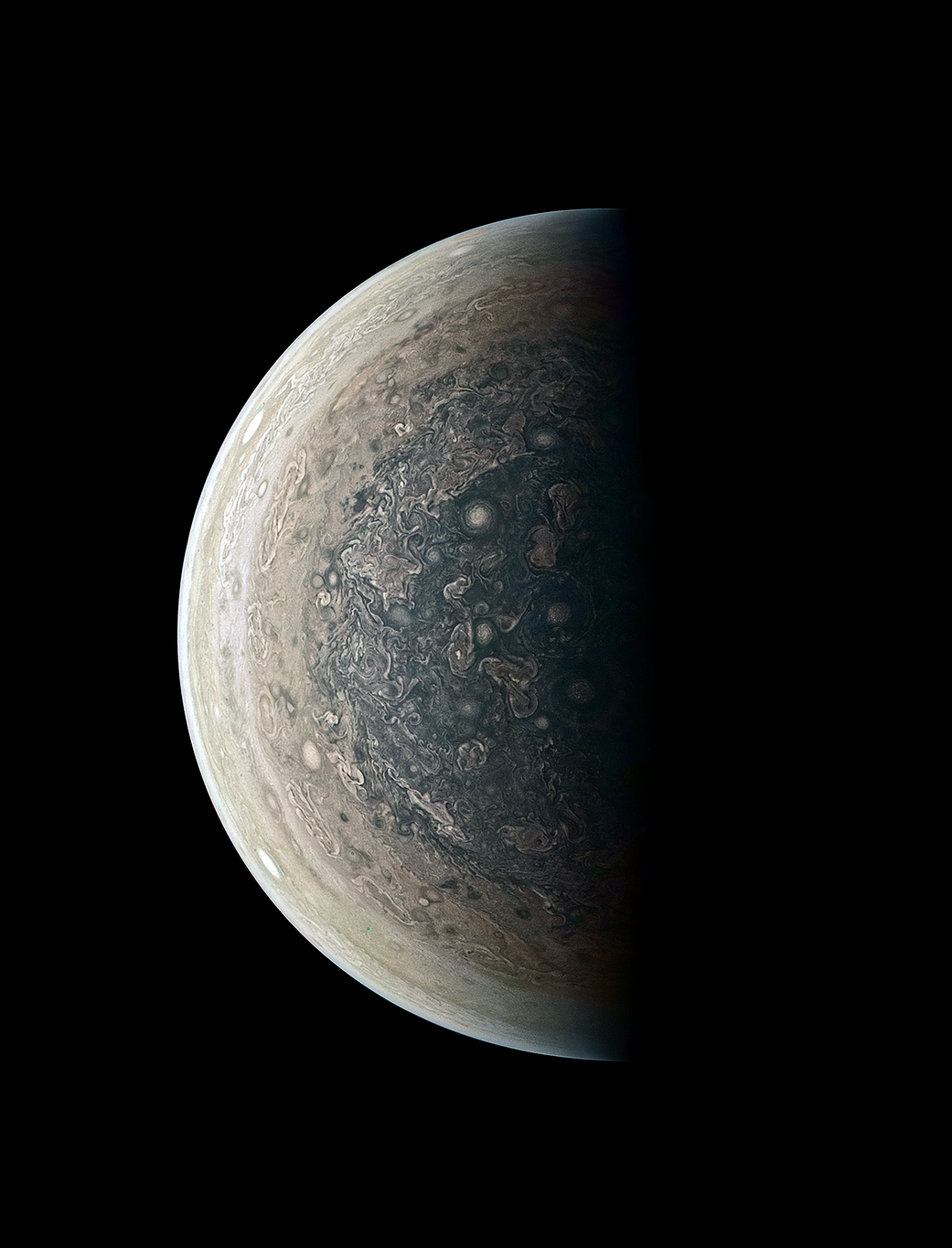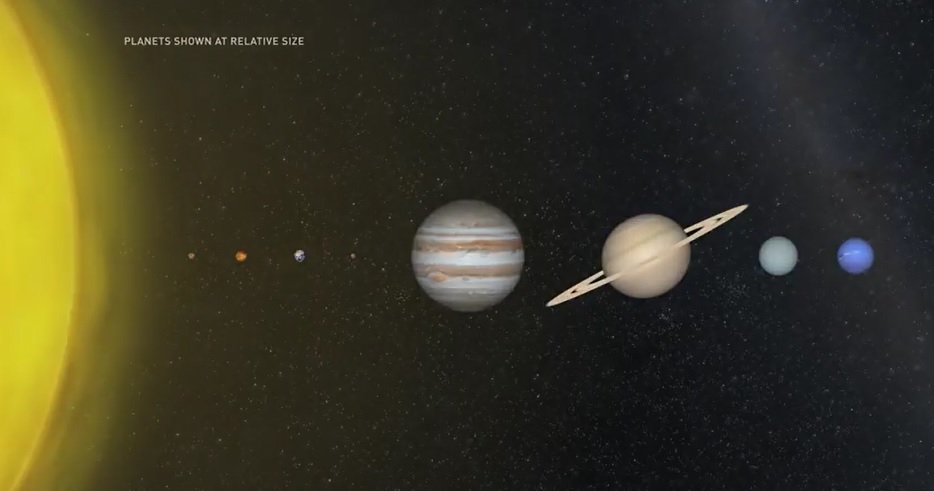先にNASAの公式サイトで触れられていたジュノーのミッション延長について、幾分詳細に触れた記事が掲載されました。
ジュノーはもともと2021年7月までのミッションでしたが、今回期間を延長し、木星の衛星(ガニメデ、エウロパ、イオ)と木星の環に最接近して観測することとなっています。
以下がNASAのオリジナル記事のURLです。
NASA’s Juno Mission Expands Into the Future | NASA
以下のオリジナル記事と和訳です。
NASA’s Juno Mission Expands Into the Future
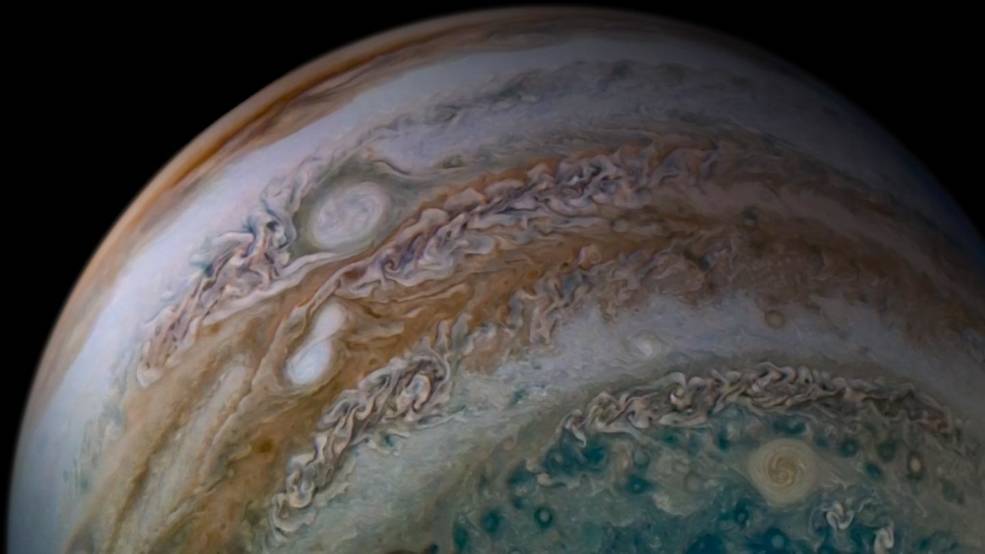
The spacecraft, which has been gathering data on the gas giant since July 2016, will become an explorer of the full Jovian system – Jupiter and its rings and moons.
2016年7月から巨大ガス惑星に関するデータを収集している探査機は、木星の環と衛星からなる木星系全体を探査することになります。
NASA has authorized a mission extension for its Juno spacecraft exploring Jupiter. The agency’s most distant planetary orbiter will now continue its investigation of the solar system’s largest planet through September 2025, or until the spacecraft’s end of life. This expansion tasks Juno with becoming an explorer of the full Jovian system – Jupiter and its rings and moons – with multiple rendezvous planned for three of Jupiter’s most intriguing Galilean moons: Ganymede, Europa, and Io.
NASAは、木星を探査するジュノー探査機のミッション延長を確定しました。木星軌道を周回している探査機は、2025年9月まで、または探査機の装置寿命が尽きるまで、太陽系最大の惑星の探査活動を継続します。このミッション延長により、ジュノーは木星の環と衛星の木星系全体の探索を行うので、その期間中に木星の最も魅力的なガリレオ衛星の3つであるガニメデ、エウロパ、イオに複数回の最接近が予定されています。
“Since its first orbit in 2016, Juno has delivered one revelation after another about the inner workings of this massive gas giant,” said principal investigator Scott Bolton of the Southwest Research Institute in San Antonio. “With the extended mission, we will answer fundamental questions that arose during Juno’s prime mission while reaching beyond the planet to explore Jupiter’s ring system and Galilean satellites.”
サンアントニオのサウスウエスト研究所の主任研究員スコットボルトンは、「2016年、最初に木星軌道投入して以来、ジュノーはこの巨大なガス惑星の内部の仕組みについて次々と啓示を提供してきました。 」「拡張ミッションでは、木星の環とガリレオ衛星を探査するための軌道に達するまでの間に、ジュノーの主要ミッションに関する質問にお答えます。」と述べています。
Proposed in 2003 and launched in 2011, Juno arrived at Jupiter on July 4, 2016. The prime mission will be completed in July 2021. The extended mission involves 42 additional orbits, including close passes of Jupiter’s north polar cyclones; flybys of Ganymede, Europa, and Io; as well as the first extensive exploration of the faint rings encircling the planet.
2003年に計画され、2011年に打ち上げられたジュノーは、2016年7月4日に木星に到着しました。主要なミッションは2021年7月に完了します。拡張ミッションには、木星の北極にあるサイクロンへの接近通過を含む42の追加軌道が含まれます。同様にガニメデ、エウロパ、イオへの最接近、木星を取り巻くかすかな環の初となる大規模な探査も計画されています。

“By extending the science goals of this important orbiting observatory, the Juno team will start tackling a breadth of science historically required of flagships,” said Lori Glaze, planetary science division director at NASA Headquarters in Washington. “This represents an efficient and innovative advance for NASA’s solar system exploration strategy.”
「この拡張ミッションにおける重要な軌道からの探査によるゴールは、ジュノーチームが、科学における歴史的な探索活動に取り組むということです。」と、ワシントンのNASA本部の惑星科学部門ディレクターであるローリーグラッゼは述べています。 「これはNASAの太陽系探査戦略の効率的で革新的な進歩となるでしょう。」
The data Juno collects will contribute to the goals of the next generation of missions to the Jovian system – NASA’s Europa Clipper and the ESA (European Space Agency) JUpiter ICy moons Explorer (JUICE) mission. Juno’s investigation of Jupiter’s volcanic moon Io addresses many science goals identified by the National Academy of Sciences for a future Io explorer mission.
ジュノーが収集するデータは、木星システムに対する次世代のミッションであるNASAのエウロパクリッパーとESA(欧州宇宙機関)のJUpiter ICy moons Explorer(JUICE)ミッションの目標に寄与することでしょう。木星の火山衛星イオに関するジュノーの探査は、将来のイオ探査計画のために国立科学アカデミーによって設定された多くの科学目標に取り組むこととなります。
The extended mission’s science campaigns will expand on discoveries Juno has already made about Jupiter’s interior structure, internal magnetic field, atmosphere (including polar cyclones, deep atmosphere, and aurora), and magnetosphere.
拡張ミッションの科学探査計画は、木星の内部構造、内部磁場、大気(極にあるサイクロン、深層大気、オーロラを含む)、および磁気圏についてジュノーがすでに行った発見に基づいて拡張されることになります。
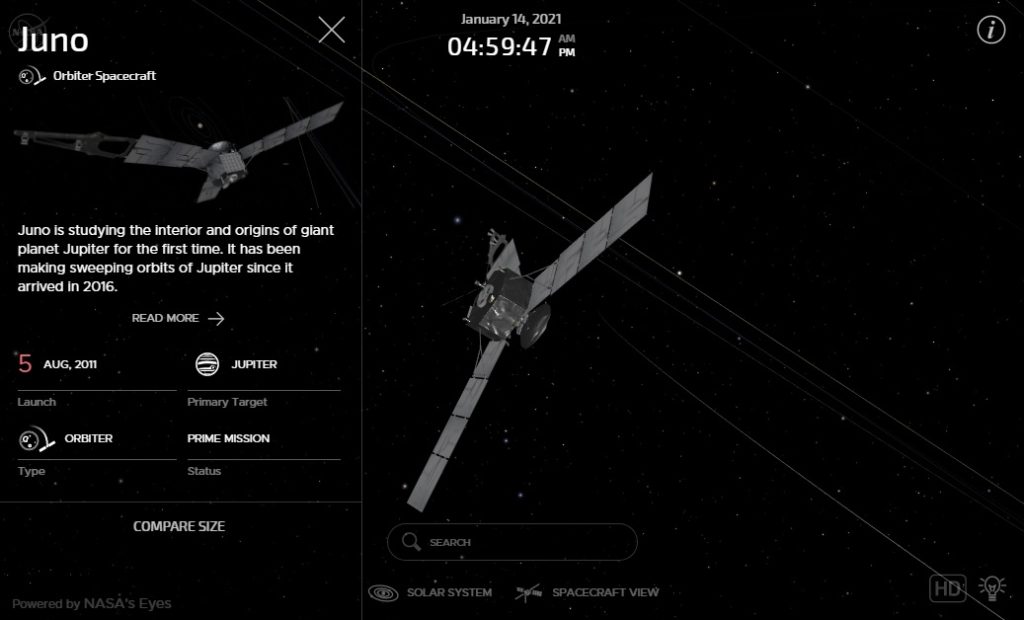
“With this extension, Juno becomes its own follow-on mission,” said Steve Levin, Juno project scientist at NASA’s Jet Propulsion Laboratory in Southern California. “Close-up observations of the pole, radio occultations” – a remote sensing technique to measure properties of a planetary atmosphere or ring systems – “satellite flybys, and focused magnetic field studies combine to make a new mission, the next logical step in our exploration of the Jovian system.”
「この拡張ミッションにより、ジュノーは独自に後続ミッションを実施することとなります」と南カリフォルニアにあるNASAのジェット推進研究所のジュノープロジェクト所属科学者であるスティーブレビンは述べています。「極地域のクローズアップ観測、電波掩蔽」-惑星の大気または環の特性を測定するためのリモートセンシング技術-「衛星への最接近と集中磁場研究を組み合わせた新しいミッションは、木星系の探査における次のステップとなるものです。」
Jupiter’s enigmatic Great Blue Spot, an isolated patch of intense magnetic field near the planet’s equator, will be the target of a high-spatial-resolution magnetic survey during six flybys early in the extended mission. As Juno’s orbit evolves, multiple flybys of the moons Ganymede (2), Europa (3), and Io (11) are planned, as well as multiple passages through Jupiter’s tenuous rings.
木星の謎めいたグレートブルースポットは、赤道近くの強烈な磁場の孤立した存在であり、拡張ミッションの初期の6回の周回中に高分解能での磁気探査の対象になります。ジュノーの軌道周回回数が進むにつれて、ガニメデ(2)、ヨーロッパ(3)、イオ(11)の衛星に及ぶ複数回の最接近と、木星の希薄な環の複数回の通過が計画されています。
Juno will also fly through the Europa and Io tori – ring-shaped clouds of ions – on multiple occasions, characterizing the radiation environment near these satellites to better prepare the Europa Clipper and JUICE missions for optimizing observation strategies and planning, science priorities, and mission design. The extended mission also adds planetary geology and ring dynamics to Juno’s extensive list of science investigations.
ジュノーはまた、エウロパとイオの環(リング状のイオンの雲)を何度も飛行し、これらの衛星の近くの放射線環境を観測し、その結果によりエウロパクリッパーとJUICEのミッションがより適切になるように、戦略と計画、優先順位などの準備となります。拡張されたミッションはまた、惑星地質学と環のダイナミクスをジュノーの広範な科学調査リストに追加します。
An Evolving Orbit
The natural evolution of Juno’s orbit around the gas giant provides the wealth of new science opportunities that the extended mission capitalizes on. Every science pass sends the solar-powered spacecraft zooming low over Jupiter’s cloud tops, collecting data from a unique vantage point no other spacecraft has enjoyed.
The point during each orbit where Juno comes closest to the planet is called perijove (or PJ). Over the course of the mission, Juno’s perijoves have migrated northward, dramatically improving resolution over the northern hemisphere. The design of the extended mission takes advantage of the continued northward migration of these perijoves to sharpen its view of the multiple cyclones encircling the north pole while incorporating ring and Galilean moon flybys.
“The mission designers have done an amazing job crafting an extended mission that conserves the mission’s single most valuable onboard resource – fuel,” said Ed Hirst, the Juno project manager at JPL. “Gravity assists from multiple satellite flybys steer our spacecraft through the Jovian system while providing a wealth of science opportunities.” The satellite flybys also reduce Juno’s orbital period, which increases the total number of science orbits that can be obtained.”
The satellite encounters begin with a low-altitude flyby of Ganymede on June 7, 2021 (PJ34), which reduces the orbital period from about 53 days to 43 days. That flyby sets up a close flyby of Europa on Sept. 29, 2022 (PJ45), reducing the orbital period further to 38 days. A pair of close Io flybys, on Dec. 30, 2023 (PJ57), and Feb. 3, 2024 (PJ58), combine to reduce the orbital period to 33 days.
More About the Mission
JPL, a division of Caltech in Pasadena, California, manages the Juno mission for the principal investigator, Scott J. Bolton, of the Southwest Research Institute in San Antonio. Juno is part of NASA’s New Frontiers Program, which is managed at NASA’s Marshall Space Flight Center in Huntsville, Alabama, for the agency’s Science Mission Directorate in Washington. Lockheed Martin Space in Denver built and operates the spacecraft.
More information about Juno is available at:
https://www.nasa.gov/juno
https://www.missionjuno.swri.edu
Follow the mission on Facebook and Twitter at:
https://www.facebook.com/NASASolarSystem
DC Agle
Jet Propulsion Laboratory, Pasadena, Calif.
818-393-9011
agle@jpl.nasa.gov
Grey Hautaluoma / Alana Johnson
NASA Headquarters, Washington
202-358-0668 / 202-358-1501
grey.hautaluoma-1@nasa.gov / alana.r.johnson@nasa.gov
Deb Schmid
Southwest Research Institute, San Antonio
210-522-2254
dschmid@swri.org
2021-008
Last Updated: Jan. 14, 2021
Editor: Tony Greicius
